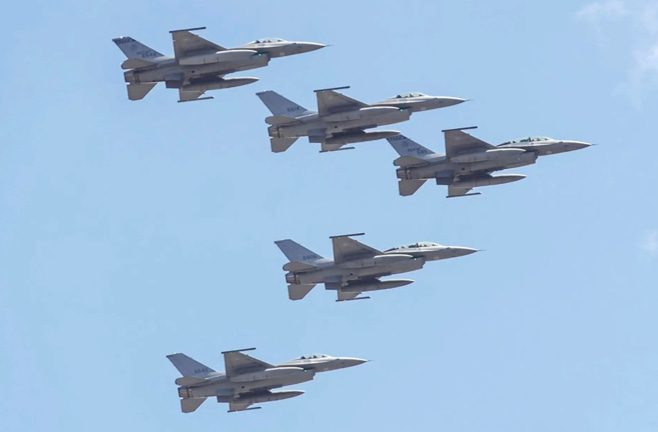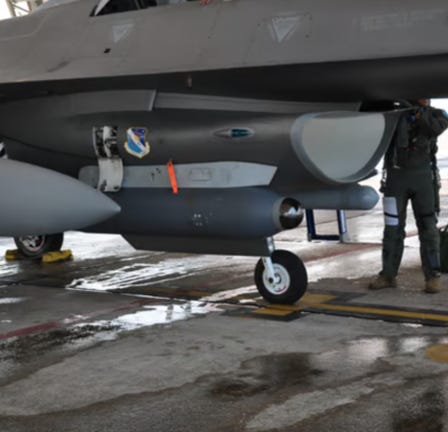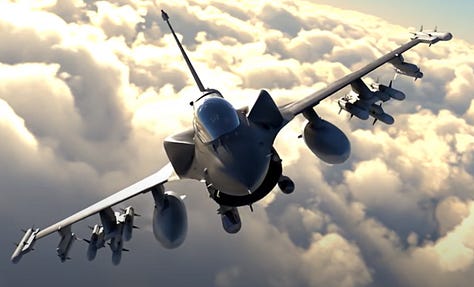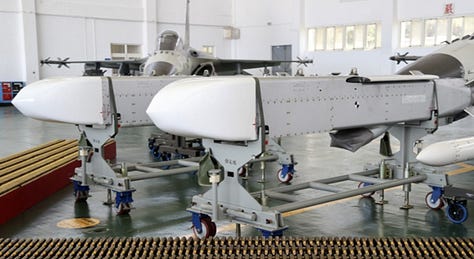Taiwanese F-16 Upgrades Will Significantly Increase its Combat Capabilities and Survivability
Both the IRST System and JASSM/Wan Chien cruise missiles will allow Taiwan's F-16s to conduct strikes at greater distance while also enabling them to passively locate and destroy J-20s and J-31s.

In September, the United States awarded Lockheed Martin an award to complete a Service Life Extension for the Republic of China Air Force’s (RoCAF) for F-16A/B Block 20 multi-role aircraft. The extension program is the latest in various upgrades to Taiwan’s fleet of F-16s that will increase the aircraft’s combat capabilities, especially against 5th generation aircraft and cruise missiles.
In September, the United States awarded Lockheed Martin an award to complete a Service Life Extension for the Republic of China Air Force’s (RoCAF) for F-16A/B Block 20 multi-role aircraft. The program will restore and strengthen the aircraft’s airframe and wings, adding thousands of hours to each aircraft that will increase the service life of the F-16s. The extension program is the latest in various upgrades to Taiwan’s fleet of F-16s that will increase the aircraft’s combat capabilities, especially against 5th generation aircraft and cruise missiles.



IRST System
In late August, the United States approved the sale of the F-16 Infrared Search and Track systems (IRST) to the Republic of China Air Force (RoCAF) for approximately $500 million USD. However, the United States did not say which system Taiwan would receive, the press release did say Lockheed Martin would be the principal contractor.
In late August, the United States approved the sale of the F-16 Infrared Search and Track systems (IRST) to the Republic of China Air Force (RoCAF) for approximately $500 million USD. The sale includes the IRST systems, integration equipment/support, aircraft and munitions equipment/support, spare parts, and logistical assistance. However, the United States did not say which system Taiwan would receive, the press release did say Lockheed Martin would be the principal contractor. Lockheed Martin produces the IRST21 – also known as the Legion Pod – is the latest iteration of the company’s IRST system first introduced in the late 1970s on the F-14 Tomcat. The IRST21 can be mounted to aircraft in various ways, such as being installed inside an aircraft’s centerline fuel tanks or in a pod that can be attached on the hardpoints of wing’s underside. Lockheed Martin displayed an F-16C/D Bock 70 mockup with an IRST sensor pod at the 2019 Taipei Aerospace & defense Technology Exhibition. The system, while similar in size to the Legion Pods mounted to F-16s, was mounted on the mockup’s underside, along its centerline. Furthermore, the mockup’s pod design contains differences from the most recent iterations of the Legion Pod. The most significant difference between the two systems is the lens on the mockup pod is triangular instead of a round lens normally found on the IRST. Another difference is the mockup system is mounted on the F-16’s centerline hardpoint instead of the underside of the wing.



JASSM and Wan Chien Cruise Missiles
The United States is likely to approve the sale of the AGM-158 Joint Air-to-Surface Standoff Missiles (JASSM) to Taiwan by the end of 2023. Taiwan also embarked on increasing production of the extended range variant of the Wan Chien 萬劍 air-to-ground cruise missile.
The United States is likely to approve the sale of the AGM-158 Joint Air-to-Surface Standoff Missiles (JASSM) to Taiwan by the end of 2023. The island began efforts to procure the JASSM in 2019 because the island is unable to buy the F-35 stealth jet aircraft or afford to develop a domestic stealth jet aircraft. Taiwan wants to acquire both the AGM-158A with a range of 230 miles (370 km) and the extended range variant, the AGM-158B, with a range of 622 miles (1,000 km) for use by its F-16Vs. Taiwan also embarked on increasing production of the extended range variant of the Wan Chien 萬劍 air-to-ground cruise missile, with a range of 249 miles (400 km). The increased production would mean that the National Chung-Shan Institute of Science and Technology (NCSIST) would produce the missiles by 2028 instead of stopping production in 2024. The increased production would mean NCSIST can produce between 50 to 60 Wan Chien missiles, with the final number ranging between 200 and 240 missiles.
Analysis: The upgrades to Taiwan’s F-16 fleet would significantly increase its both its survivability and combat capabilities. The IRST systems will enable the F-16s to acquire and target Chinese fifth generation aircraft such as the J-20 Mighty Dragon威龙and J-31 Gyrfalcon鹘鹰 using the aircraft’s heat. The systems would also allow the F-16s equipped with them to also track and target various cruise missiles such as the YJ-18C 鹰击-18C or CJ-10A长剑-10A. However, the most important aspect of the IRST system is how it will allow the F-16s to passively target the aircraft without being detected. Furthermore, the targeted aircraft would not have the ability to determine the F-16’s location due to the pod’s passive nature. The IRST system is also not affected by any electronic warfare jamming methods or techniques, allowing the F-16s to target aircraft without any interference. However, the ISRT system does have limitations, such as the atmospheric conditions negatively affecting its range and perception. The most significant limitation is the inability for the sensor to provide a range for targets due to the sensor’s 2D nature.
The sensor can only provide the target’s bearing and would need another sensor such as a radar to determine the range to develop a firing solution. One solution the RoCAF could utilize is to develop hunter-killer teams of F-16Vs that would hunt for aircraft or missiles using the IRST system to develop a more accurate firing solution. The IRST system has the capability to send and receive information through datalinks built into the pod itself instead of the aircraft. The datalinks would allow the IRST system to share information about targets it acquires with other aircraft without worrying about bandwidth or other radio frequency limitations. For example, the IRST-equipped F-16s could send or receive information from RoCAF aircraft such as the F-CK-1 Ching-kuo/Indigenous Defense Fighter (IDF) 經國號戰機 or U.S. aircraft such as the F-15C or the F-35. The aircraft would use the pod’s datalinks that would share information that would enable the aircraft to develop a range and bearing that could be used to create an accurate firing solution.
The JASSM and the Wan Chien cruise missiles would allow the F-16Vs to conduct airstrikes against various Chinese targets at increased standoff ranges. The JASSM’s extended range variant would enable the F-16s to strike military and strategic targets located the Chinese mainland. These targets would be located as far as Hainan province (south), as far as the city of Qingdao/Shandong Peninsula (north), and as far as the city of Chongqing (west). The IDF could also be modified to carry and fire both variants of the JASSMs to enable the RoCAF more options to strike targets along most of the Chinese coastline. The Wan Chien cruise missiles would also allow the RoCAF to strike targets like the JASSM but at significantly smaller ranges. The cruise missile allows the IDF to strike targets as far north of the cities of Shanghai and Nantong, as south as the vicinity of Haina province, and as far west as the city of Changsha. The weapon could also be used to destroy airport or airbase runways to deny the People’s Liberation Army (PLA) the ability to use them to conduct airstrikes against the island or logistical operations. The RoCAF could use both the JASSM and Wan Chien missiles to target troop assembly areas, transportation infrastructure, or naval and repurposed civilian amphibious vessels to disrupt any invasion plans. Furthermore, the cruise missiles could also be used to target the same locations as the JASSMs, enabling them to save the JASSMs for more important targets such as Command and Control nodes. Taiwan also can build more of the Wan Chien cruise missiles, allowing them to rapidly replenish their stocks without relying on outside countries such as the United States.



